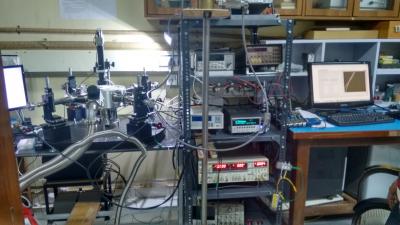
Semiconductors and superconductors are generally thought to be two very different types of materials. Indeed superconductors are usually metals, alloys and certain oxides with high electron densities. Semiconductors have much lower electron densities. However there are some semiconductors which become superconducting at low temperatures. This brings up interesting questions about how low the carrier density could be that still leads to an over screened phonon mediated electron-electron interaction, leading to formation of copper pairs.Only a few semiconductors like Tin Telluride, Indium Nitride, etc. show a superconducting phase at temperatures around 4 kelvin and below. We are (in collaboration with other groups in the institute) working on these materials. In our lab, low temperature magneto-transportstudies are done. Using evaporative cooling of liquid Helium-3 we are able to reach temperatures down to 280 millikelvin. We are working towards optimising Indium Nitride based structures and trying to make Josephson micro-constrictions (superconductor-normal metal- superconductor junctions)whose parameters may be tuned.
We have also been investigating mesoscopic structures (less than 1 micron in size) in which superconducting electrons are injected into a semiconductor like high mobility Gallium Nitride using superconducting metallic leads. We were able to show recently that such proximity induced superconductivity can be sustained in a non-superconducting material in magnetic fields as high as 6 Tesla.
In addition, we have also developed a measurement system for investigating conductivity fluctuations using a two-amplifier correlator, sensitive enough to detect thermal fluctuations (Johnson noise) across resistances as low as 10 ohms. Such measurements can be used to probe internal relaxation times and traps in materials that a simple conductivity measurement cannot yield.
Prof. Kantimay Das Gupta
